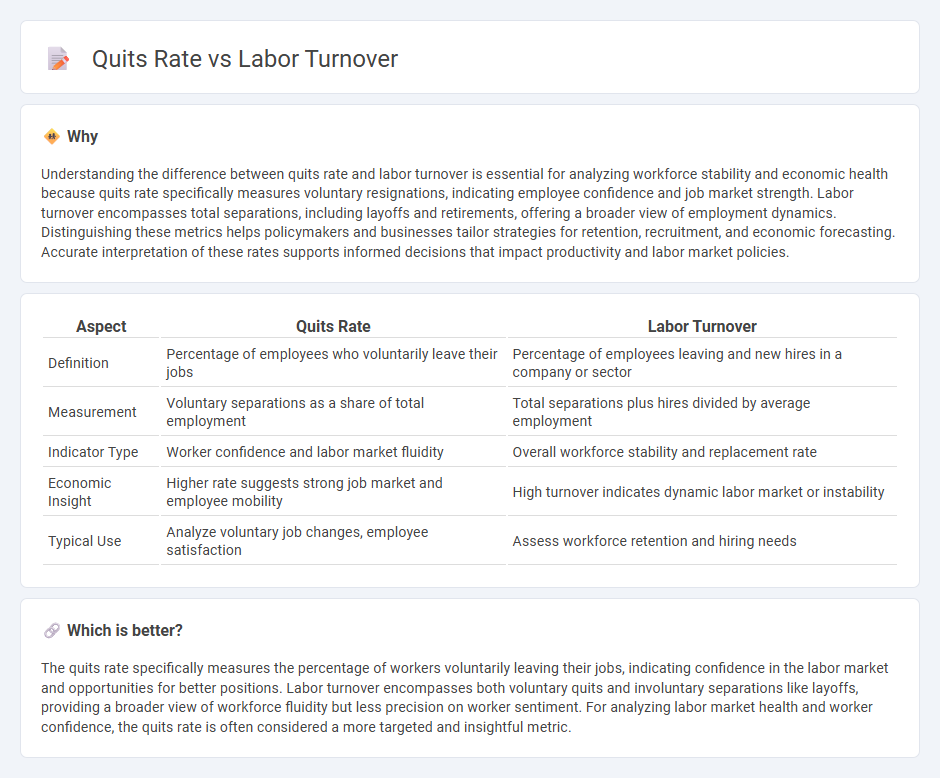
The quits rate measures the proportion of employees voluntarily leaving their jobs, offering insights into workers' confidence and labor market conditions. Labor turnover encompasses both voluntary quits and involuntary separations such as layoffs, providing a broader picture of workforce changes. Explore detailed trends and implications of quits rate versus labor turnover for a comprehensive understanding of economic health.
Why it is important
Understanding the difference between quits rate and labor turnover is essential for analyzing workforce stability and economic health because quits rate specifically measures voluntary resignations, indicating employee confidence and job market strength. Labor turnover encompasses total separations, including layoffs and retirements, offering a broader view of employment dynamics. Distinguishing these metrics helps policymakers and businesses tailor strategies for retention, recruitment, and economic forecasting. Accurate interpretation of these rates supports informed decisions that impact productivity and labor market policies.
Comparison Table
| Aspect | Quits Rate | Labor Turnover |
|---|---|---|
| Definition | Percentage of employees who voluntarily leave their jobs | Percentage of employees leaving and new hires in a company or sector |
| Measurement | Voluntary separations as a share of total employment | Total separations plus hires divided by average employment |
| Indicator Type | Worker confidence and labor market fluidity | Overall workforce stability and replacement rate |
| Economic Insight | Higher rate suggests strong job market and employee mobility | High turnover indicates dynamic labor market or instability |
| Typical Use | Analyze voluntary job changes, employee satisfaction | Assess workforce retention and hiring needs |
Which is better?
The quits rate specifically measures the percentage of workers voluntarily leaving their jobs, indicating confidence in the labor market and opportunities for better positions. Labor turnover encompasses both voluntary quits and involuntary separations like layoffs, providing a broader view of workforce fluidity but less precision on worker sentiment. For analyzing labor market health and worker confidence, the quits rate is often considered a more targeted and insightful metric.
Connection
Quits rate, a measure of voluntarily leaving employees, directly impacts labor turnover by reflecting workforce mobility and job market confidence. High quits rates often indicate a strong economy where workers feel secure in finding new employment, which increases overall labor turnover. Understanding the relationship between quits rate and labor turnover helps businesses anticipate staffing challenges and adjust recruitment strategies accordingly.
Key Terms
Employee retention
Labor turnover measures the total rate at which employees leave a company, including quits, layoffs, and retirements, while the quits rate specifically tracks voluntary resignations, reflecting employee confidence in job market opportunities. High quits rates often indicate underlying issues in employee satisfaction or workplace conditions, making it a critical metric for enhancing employee retention strategies. Explore detailed insights on improving retention by analyzing labor turnover and quits data more effectively.
Separation rate
Labor turnover measures the total number of employees who leave a company, including quits, layoffs, and retirements, while the quits rate specifically reflects voluntary separations initiated by employees. The separation rate combines all forms of employee exits, providing a holistic view of workforce stability and potential operational impacts. Explore more to understand how these metrics influence organizational retention strategies.
Voluntary exits
Labor turnover measures the total number of employees leaving an organization, encompassing both voluntary exits, like quits, and involuntary separations, such as layoffs or dismissals. The quits rate specifically tracks voluntary exits, reflecting workers' confidence in finding new employment and indicating labor market strength. Explore the detailed differences and implications of these metrics to optimize workforce management strategies.
Source and External Links
Labour Turnover: Define It, Understand It, Calculate It Today - Labour turnover is the net departure of employees from an organization over a defined period and impacts costs, expertise loss, and business performance; it includes voluntary/involuntary and avoidable/unavoidable types.
Labor Turnover: Meaning and Best Practices - Labor turnover is the rate at which employees leave and are replaced, categorized as voluntary or involuntary, affecting productivity, costs, and morale in an organization.
Employee turnover - Labor turnover rate is calculated as employees leaving divided by the average number of employees over a period, expressed as a percentage, with more precise methods available to avoid data distortion.
 dowidth.com
dowidth.com